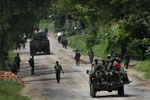
Last week the Harvard Humanitarian Initiative and Oxfam America published an in-depth report investigating sexual violence in eastern Congo. The report, based upon a rigorous analysis of the records at Panzi Hospital (a hospital in South Kivu that specializes in caring for survivors), adds welcome analytic heft to our understanding of the impact of sexual violence in this area.
Media reports have focused upon the dramatic increase in civilian rape that is among the reports main findings. This is a particularly tragic but unsurprising consequence of the Congo’s ongoing conflict, as the widespread use of rape during wartime often leads to what the report calls “a normalization of rape among the civilian population”—a phenomenon not uncommon in post-conflict settings.
It’s worth noting that the report provides only a limited view of the sexual violence problem. Because it is based on documentation from South Kivu’s Panzi Hospital, it is specific to that region and looks only at data from 2004 through 2008. During this period, violence in South Kivu waned and violence predominantly affected North Kivu. Given the spike in violence in South Kivu as a result of military operations last year, we could well see a corresponding rise in sexual violence in more recent data.
Alongside sensible policy recommendations, the report’s authors also suggest a number of compelling areas for future research, including a specific examination of sexual violence in mining areas:
“The coltan and gold mines of North and South Kivu have long been hotbeds of militia activity, child labor and sexual exploitation of the surrounding population. We speculate that local mining communities have been predisposed to rape as a weapon of war by virtue of their close proximity to the mines and the armed military groups operating in the surrounding areas. Little is known, however, about the relationship between sexual violence and the struggle to control these rich natural resources. Further research in these areas can shed light on the predatory behaviors of militias and promote strategies for the protection of women and girls in local mining communities.”
Photo: Fighting in eastern Congo. (AP)

